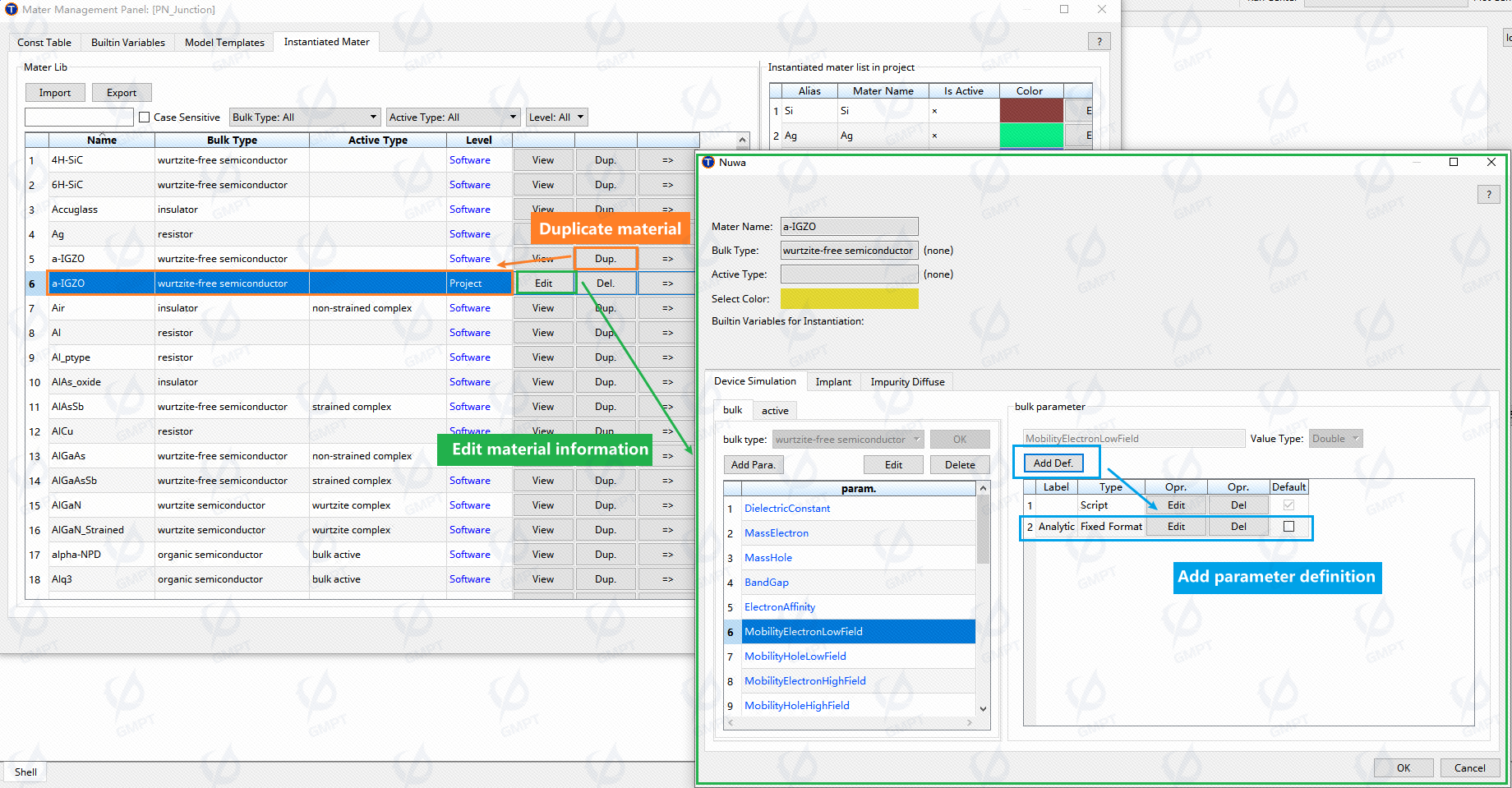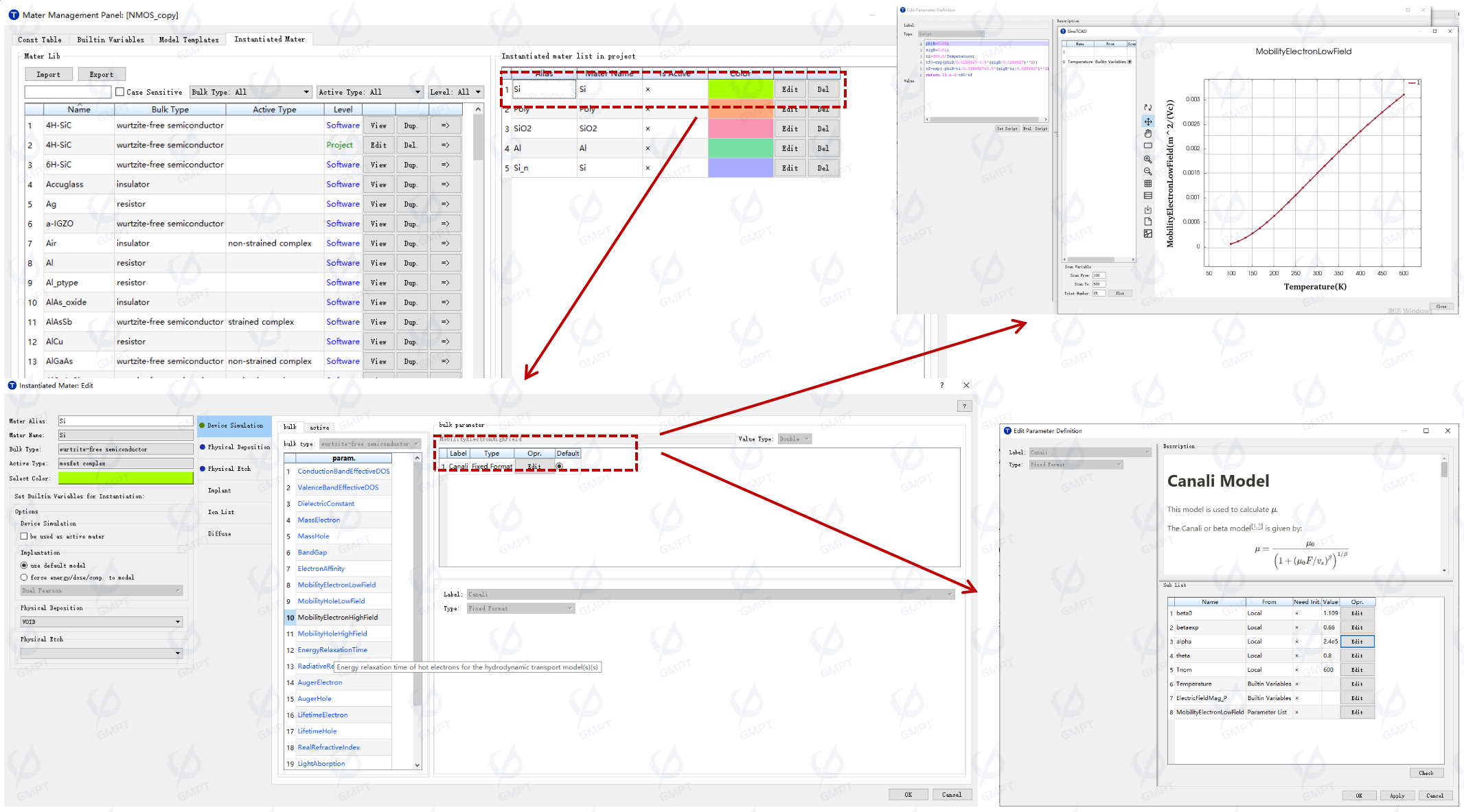- Features
- Process Simulation
- Efficiency Features
Material Library
GMPT, October 2024
The material library is an essential component of TCAD simulation software, providing critical information on semiconductor materials for process and device simulation. Nuwa TCAD simulation tools support user customization of the material library, covering various materials with attributes, including key material characteristic parameters and models for process and device simulation.
Customizable Material Library
Nuwa TCAD simulation tools support the customization of the material library, with main features including:
- Support for adding new materials, saving these materials and their model parameters in the software, and setting the hierarchy level of the new materials.
- Support for copying materials and modifying their parameters for subsequent use.
- Device simulation parameters support various definitions, including fixed model formulas, user-defined scripts, fixed values, lists, etc.
- For current projects, users can import materials from the material library and customized materials into an instantiated material library and modify their material parameters for use in current project process and device simulations.

Material Simulation Models and Parameter List
Based on the attributes of materials and their needs for process and device simulation, the material library of Nuwa TCAD simulation tools has a comprehensive list of material simulation models and parameters:
- Device simulation parameters, such as electron/hole mobility, electron/hole effective mass, bandgap width, effective density of states in the conduction/valence bands, etc.
- Physical deposition models and parameters, including PECVD, PVD, and their parameter lists.
- Physical etching models and parameters, including isotropic etching, reactive ion etching, etc.
- Ion implantation models and parameters, including Pearson, Dual-Pearson models, and SIMS doping distribution data.
- Diffusion and oxidation models and parameters.

Visualization Analysis of Material Parameters
For parameters in the material library, visualization analysis can be conducted to facilitate user analysis of physical mechanisms and check parameter accuracy.

Covering Various Material Attributes
The material library contains over 130 common materials, covering conductors, insulators, inorganic semiconductors, organic semiconductors, and other material attributes.
| 1. Metal Materials |
| Tungsten, ITO, ZnO, Cu, Ag, AuGeNi, Au, Mo, Be, Mg, Ca, Sr, Ba, Nb, Fe, Zn, Cd, Al, Poly, LiF_Al, Ga, In, Tl, Sn, Pb, Pd, Ni, Pt, Bi, Sb, Ti, NiSi |
| 2. Insulator Materials |
| Glass (Accu-Glass), SiO2, TiO2, Vacuum, Air, SiN, Oxynitrides, Photoresist, AlAs, Iron Oxide, Indium Phosphide, Hafnium Oxide, Al2O3, Sapphire, cfilter, graphene, quartz |
| 3. Elemental Semiconductor Materials |
| Silicon, Polysilicon, Amorphous Silicon, Germanium |
| 4. Binary Compound Semiconductor Materials |
| GaAs, InP, SiC, Amorphous Germanium Silicon, Amorphous Silicon Carbide, Germanium Silicon, GaN, AlN, InN, Hexagonal SiC, GaSb, InAs, GaP, SiN, Al2O3, InSb, CdS, ZnO, ZnTe, ZnSGaO |
| 5. Ternary Compound Semiconductor Materials |
| InGaAs, InGaP, AlGaAs, ZnCdSe, InAlP, AlGaAs, InGaN, AlGaN, AlAsSb, GaPSb, HgCdTe, HfSiO4, InGaSb, GaAsSb, InAlAs, ITO |
| 6. Quaternary Compound Semiconductor Materials |
| Indium Gallium Zinc Oxide (IGZO), ZnMgSSe, InGaAsP, InGaAlP, InGaAlAs, AlGaAsSb, InGaAsN, Cu(InGa)Se2, LaCuOSe, BeZnSeTe |
| 7. Quinary Compound Semiconductor Materials |
| InGaAlPSb, InGaAsNSb, InGaNZnO |
| 8. Organic Semiconductor Materials |
| m-mtdata, alpha-npd, alq3, lif, npb, tpd, bphen, cbp |